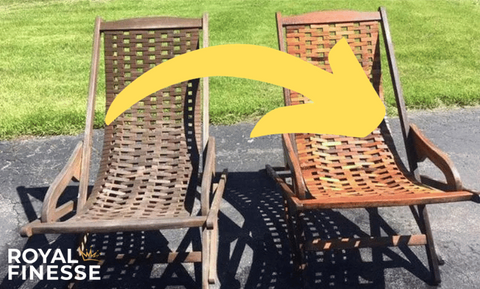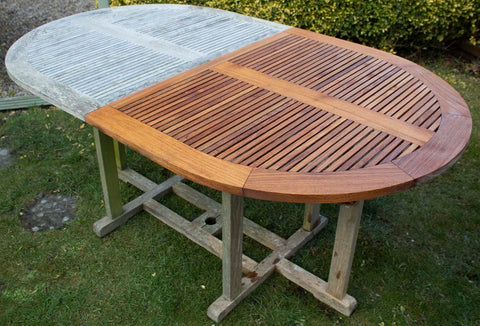How To Restore Teak Garden Furniture

Do you have teak furniture that is looking weathered and worn? Don't worry, the professionals at Royal Finesse are here to show you how you can restore teak to its former glory. With a little bit of care and attention, your teak outdoor furniture can regain its natural beauty and last for many years to come.
What Is Teak Wood?
Teak wood originates from the Tectona grandis tree, native to the tropical regions of Southeast Asia. It's a highly sought-after material due to its remarkable characteristics, making it an excellent choice for various applications, including boat building, exterior construction, and furniture including teak tables and chairs, loungers and benches.
Teak's rich golden tone, coupled with its fine wood grain, lends a touch of elegance wherever it's employed. Over time, untreated teak gracefully ages into a distinguished silvery-grey patina, symbolising its weather-endurance.
Using Teak for Outdoor Furniture?
Teak is highly prized for its remarkable durability, making it a preferred choice for outdoor furnishings. Its intrinsic resistance to termites and other pests sets it apart as a robust material capable of withstanding the test of time and the elements.
Beyond durability, one of the standout features of teak is its innate resilience to extreme weather conditions. Whether faced with relentless rain, scorching sun, or snowy winters, teak maintains its structural integrity, showcasing a level of weather resistance that makes it a reliable choice for garden furniture year-round.
In addition to its hard-wearing nature, teak is relatively low maintenance compared to other woods. Its natural oils play a pivotal role in preserving the wood, significantly reducing the need for varnishes or sealants.
Benefits of Restoring Teak Furniture
Restoring your teak furniture offers several benefits that are worth considering:
-
Cost-Effective: Restoring your teak furniture is a cost-effective alternative to buying new pieces. Instead of spending a significant amount of money on new furniture, you can breathe new life into your existing pieces at a fraction of the cost.
-
Preservation of Natural Beauty: Teak furniture is known for its stunning natural beauty. Over time, exposure to the elements can cause the wood to fade and lose its luster. By restoring it, you can bring back the rich, warm tones and natural grain of the wood, enhancing the overall aesthetic appeal.
-
Longer Lifespan: Properly restoring and maintaining your teak furniture can extend its lifespan. By addressing any damage or wear early on, you can prevent further deterioration and ensure that your furniture remains sturdy and functional for years to come.
Proper Maintenance
Proper maintenance is key to prolonging the life of your teak furniture. Here are some important tips to keep in mind:
-
Cleaning: Regularly clean teak wood furniture with a mild detergent and a soft brush to remove dirt and grime. Avoid using harsh chemicals or abrasive cleaners that may damage the wood.
-
Sealing: Applying teak sealers or teak oil can help protect the wood from moisture and maintain its natural color. Be sure to follow the manufacturer's instructions and reapply the sealer as needed.
-
Storage: If you live in an area with harsh weather conditions, consider storing your teak furniture indoors during the colder months or covering it with a protective cover.
By following these simple steps, you can restore your teak wooden furniture and enjoy its beauty and durability for years to come.
Assessing the Condition
When it comes to restoring teak furniture, it's essential to assess the condition of the piece before diving into any restoration efforts. By following these key steps, you can ensure the best possible outcome for your teak furniture restoration project.
Inspection and Evaluation of Teak Furniture
The first step in restoring teak furniture is to inspect it thoroughly. Examine the entire piece for any visible damage such as cracks, splits, or loose joints. Check for any signs of mold, mildew, or discoloration as well. Take note of any areas that require more attention during the restoration process.
Determining the Extent of Damage
Once you've inspected the furniture, it's important to determine the extent of the damage. Some issues can be easily fixed, while others may require more extensive restoration work. Assess whether the damage is purely cosmetic or if it affects the structural integrity of the furniture. This will help you decide the level of restoration needed.
Cleaning and Preparing the Surface
Before starting the restoration process, you'll need to clean and prepare the surface of the teak furniture. Begin by removing any dirt, dust, or old finishes using a mild cleanser and a soft brush. Rinse the furniture thoroughly and allow it to dry completely. Once dry, sand the entire surface using fine-grit sandpaper to smooth out any imperfections and create a clean and even base for refinishing.
Remember: Always follow the manufacturer's instructions when using a teak cleaner, and wear appropriate protective gear such as rubber gloves and a mask. Preparing the surface properly is crucial for achieving a successful teak furniture restoration.
How To Restore Teak Garden Furniture

Have you recently acquired a piece of teak furniture that has seen better days? Don't worry, with a little bit of effort and some simple steps, you can restore it to its former glory. Here are some key points to consider when restoring teak furniture.
Sanding and Removing Old Finishes
The first step in restoring teak furniture is to sand it down to remove any old finishes or imperfections. Start by using a coarse grit sandpaper and sanding block to remove the outer layer of the finish. Gradually move to finer grits until the surface is smooth. Remember to sand with the grain of the wood to avoid any damage. After sanding, wipe off any dust with a clean cloth. Remember to always wear eye protection when sanding.
Applying Teak Oil
Once the furniture is sanded, it's time to apply teak oil or sealer to protect the wood and bring out its natural beauty. Choose a high-quality teak oil or sealer specifically designed for outdoor teak furniture. Apply a thin even layer with a clean cloth or brush, making sure to cover all surfaces. Allow the oil or sealer to penetrate the wood for the recommended amount of time, then wipe off any excess.
Repairing Cracks
If your teak furniture has any cracks or damaged areas, it's important to repair them before applying any finish. Use wood filler or epoxy resin to fill in the cracks and damaged areas. Smooth out the filler with a putty knife and let it dry completely. Once dry, sand the repaired areas to blend them with the rest of the wood.
By following these simple steps, you can restore your teak furniture and enjoy its beauty for years to come. Remember to always take proper care of your teak furniture to maintain its longevity and preserve its natural appearance. With a little bit of time and effort, your teak furniture will look as good as new.
Maintaining Teak Furniture
Teak's enduring allure stems from its robustness and innate elegance, making it a top-tier choice for outdoor furnishings. Nevertheless, without adequate upkeep, the charm of teak furniture can fade over time. Here’s a deeper insight into the essential steps to prolong the elegance and durability of your teak treasures:
Regular Cleaning and Dusting
Regular cleaning is pivotal in maintaining the aesthetic and structural integrity of teak furniture. It helps in removing accumulated dirt, stains, and grime that could mar its appearance over time.
1. Cleaning Procedure:
- Initial Wipe Down: Begin by wiping the furniture using mild soap, a soft cloth or sponge dipped in warm water. Gentle cleaning agents are key as abrasive cleaners could lead to scratches or damages on the wood surface.
- Rinsing: After cleaning, a thorough rinse is necessary to wash off the soap residues. This step also helps in restoring the wood's natural texture.
- Air Drying: Allow the furniture to air dry completely. This natural drying process helps in retaining the wood’s inherent oils which contribute to its long-lasting beauty.
Avoid using a power or pressure washer on teak furniture as these devices can weaken the joints and strip away the natural protective oils of the teak.
2. Dusting:
Apart from cleaning, regular dusting is instrumental in keeping dust and debris at bay. Utilize a soft-bristle brush or a clean cloth to dust off the surface and the crevices between the teak slats to maintain its polished look.
Reapplying Teak Oil or Sealer
Teak wood may lose some of its natural oils due to constant exposure to external elements, which might lead to a dry or weathered appearance. Reapplying teak protector or sealer is a preventive measure to restore teak garden furniture and prevent weathering.
1. Preparation:
Before the reapplication process, ensure that the furniture is impeccably clean and utterly dry. This prep work lays a conducive foundation for the oil or sealer to penetrate effectively.
2. Application Process:
- Even Application: Use a clean cloth or brush to apply the teak oil or sealer evenly, following the wood’s grain to enhance its natural patterns.
- Penetration Time: Allow about 15 minutes for the oil or sealer to soak into the wood, enriching its fibers and replenishing its innate oils.
- Wiping Off Excess: Wipe off any excess oil or sealer with a clean cloth to avoid a sticky residue, and let the furniture dry thoroughly before using it.
By adhering to a regular cleaning schedule and annual reapplication of teak oil or sealer, the natural allure of your teak furniture remains unblemished, guaranteeing a prolonged lifespan.
Tips and Tricks
Choosing the Right Teak Oil
When it comes to restoring teak furniture, one of the most critical steps is selecting the right teak oil or sealer. Here are a few things to consider:
-
Natural or Synthetic: Determine whether you prefer a natural teak oil, which enhances the wood's natural color, or a synthetic sealer that provides a more durable finish.
-
UV Protection: Look for a product that offers UV protection to prevent the furniture from fading and deteriorating when exposed to sunlight.
-
Easy Application: Choose a teak oil or sealer that is easy to apply and doesn't require extensive preparation or maintenance.
Common Restoration Mistakes
Restoring teak furniture requires care and attention to detail. Here are some common mistakes to avoid:
-
Avoid Over-sanding: While it may be tempting to sand away imperfections, over-sanding can damage the natural patina of the teak wood. Use a fine-grit sandpaper and sand in the direction of the grain for best results.
-
Don't use too much oil or sealer: Applying an excessive amount of teak oil or sealer can lead to a sticky or greasy surface. Follow the product instructions carefully and apply thin, even coats.
-
Don't skip the cleaning step: Before applying any oil or sealer, make sure to clean the furniture thoroughly with clean water to remove dirt, grime, and old coatings. This will ensure that the teak absorbs the new finish evenly and effectively.
Restoring teak furniture is a cost-effective, environmentally friendly, and personally satisfying way to preserve and enhance the natural beauty and smooth finish of your teak piece of furniture.
Choose Our Furniture Restoration Kit
As well as beautiful teak furniture, Royal Finesse offer Furniture Clinics teak garden furniture restoration kit to keep your teak furniture looking great and in top condition.
Check out Furniture Clinics video on how to restore Teak Furniture below;
By following proper restoration techniques and using quality products, you can enjoy your teak furniture for many years to come. As well as beautiful teak furniture, Royal Finesse offer Furniture Clinics teak garden furniture restoration kit to keep your teak furniture looking great and in top condition.


